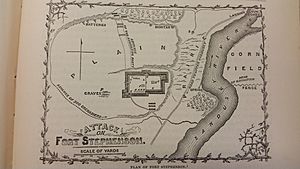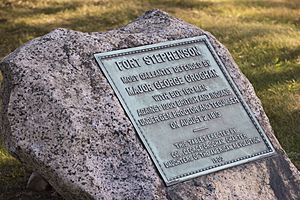Fort Stephenson facts for kids
Quick facts for kids Fort Stephenson |
|
|---|---|
| Fremont, Ohio | |

Fort Stephenson
|
|
| Type | Fort |
| Site information | |
| Controlled by | |
| Site history | |
| Built | 1812 |
| In use | ????-???? |
Fort Stephenson was an important fort built in the early 1800s. It was located on the west side of the lower Sandusky River. This fort became famous in 1813 for an American victory during the War of 1812. This battle is known as the Battle of Fort Stephenson.
The town that grew up around the fort was first called "Lower Sandusky." This was because it was near the lower part of the river. Later, it was renamed Fremont, Ohio. The area was also home to a historic Wyandot village called Junquindundeh.
Building Fort Stephenson
The area where Fort Stephenson was built was important. It was near the falls of the Lower Sandusky River. Ships could not travel past this point. This made it a good spot for a settlement.
European-American settlers also built homes here. Fort Stephenson was first known as Fort Sandusky. It was built in the early 1800s. The fort had two strong blockhouses. These were connected by a wall made of tall, vertical logs. Another blockhouse was inside the fort.
The fort's main job was to protect the Lower Sandusky area. It also guarded a nearby supply depot. This was during the War of 1812 with Great Britain. The United States thought attacks might come from Lake Erie and Canada. In 1812, Major George Croghan became the leader of the fort. He had about 150 to 160 soldiers with him.
The Battle of Fort Stephenson
On August 1, 1813, a large group attacked Fort Stephenson. This group included British soldiers and their Native American allies. They had between 1,500 and 2,000 fighters. The fort's defenders were greatly outnumbered. Major George Croghan led only about 160 men.
Over two days, Croghan's men fought bravely. They used their shooting skills and one cannon very well. This cannon was nicknamed "Old Betsy." The British forces tried to break into the fort but failed. The British general decided not to continue the attack. He pulled his forces back to Canada. This was a big victory for the Americans.
Remembering Fort Stephenson
After the war, the US army left the fort. Over time, the fort fell apart. Settlers even took wood from it. By the late 1800s, not much was left. Only some stone walls and the cannon "Old Betsy" remained.
Today, the site of the fort is a park. It is called Fort Stephenson State Park. This park helps to protect what is left of the fort. It also celebrates the American victory. The famous cannon "Old Betsy" is still there. It looks out over the northern part of the park.
The main branch of Birchard Public Library is also in the park. It was built in 1878. This library serves all of Sandusky County.
The city also honors Major Croghan. They have a special day called "Croghan's Day." In 1885, the Sandusky County Soldiers Monument was put in the park. Former President Rutherford B. Hayes was there for the event.
In 1906, Major Croghan's remains were brought to the park. They were buried under the soldiers' monument. The Daughters of the American Revolution (DAR) added a special plaque to the monument. This plaque honors Major Croghan's leadership. It also celebrates his soldiers' bravery.
The plaque says:
"Fort Stephenson most gallantly defended by Major George Croghan with but 160 men against 1300 British and Indians under Henry Proctor and Tecumseh on August 2, 1813 ___ This tablet erected by Col. George Croghan Chapter Daughters of the American Revolution 1903."
The monument is in front of the library. It is on Croghan Street, which is named after the officer. Major Croghan was promoted to Lt. Colonel for his success in the battle.


